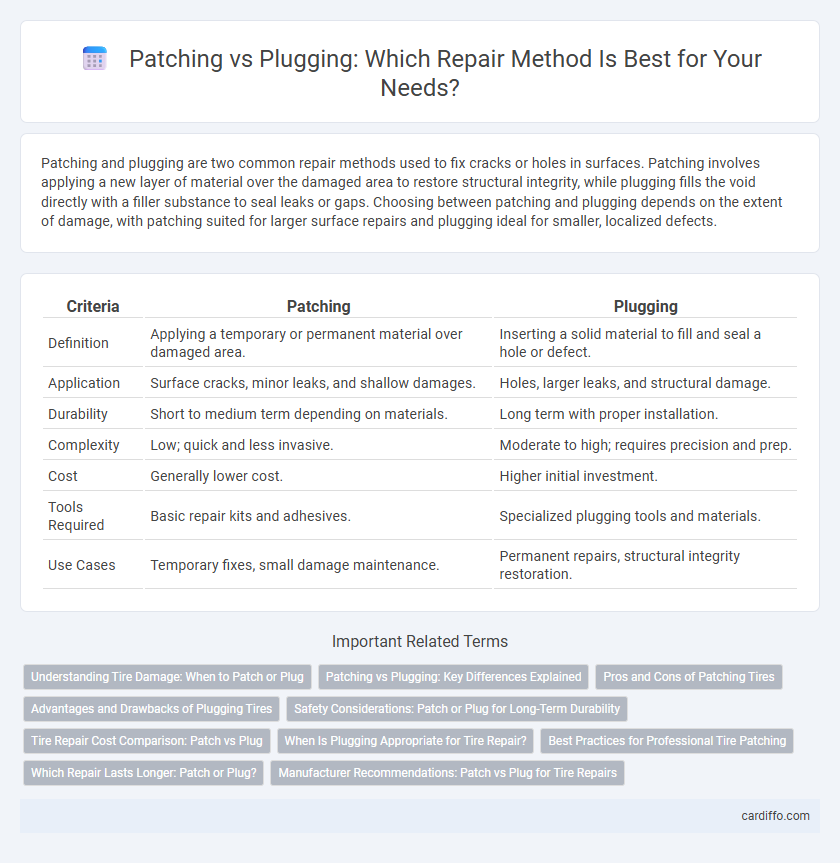Patching and plugging are two common repair methods used to fix cracks or holes in surfaces. Patching involves applying a new layer of material over the damaged area to restore structural integrity, while plugging fills the void directly with a filler substance to seal leaks or gaps. Choosing between patching and plugging depends on the extent of damage, with patching suited for larger surface repairs and plugging ideal for smaller, localized defects.
Table of Comparison
| Criteria | Patching | Plugging |
|---|---|---|
| Definition | Applying a temporary or permanent material over damaged area. | Inserting a solid material to fill and seal a hole or defect. |
| Application | Surface cracks, minor leaks, and shallow damages. | Holes, larger leaks, and structural damage. |
| Durability | Short to medium term depending on materials. | Long term with proper installation. |
| Complexity | Low; quick and less invasive. | Moderate to high; requires precision and prep. |
| Cost | Generally lower cost. | Higher initial investment. |
| Tools Required | Basic repair kits and adhesives. | Specialized plugging tools and materials. |
| Use Cases | Temporary fixes, small damage maintenance. | Permanent repairs, structural integrity restoration. |
Understanding Tire Damage: When to Patch or Plug
Tire damage assessment is crucial to determine whether to patch or plug a tire effectively. Patching is recommended for larger punctures or damage on the inner liner, providing a more durable and safe repair by sealing the tire from the inside. Plugging suits minor punctures in the tread area only, as it fills the hole temporarily but may not restore full structural integrity.
Patching vs Plugging: Key Differences Explained
Patching involves applying a material over a damaged surface to restore integrity and prevent further deterioration, commonly used for cracks or holes in concrete and asphalt. Plugging focuses on filling or sealing localized voids or leaks, often employing mechanical plugs or specialized compounds for immediate containment. Patching typically offers a more durable, structural repair, while plugging is a quicker, temporary solution designed to stop leakage or ingress.
Pros and Cons of Patching Tires
Patching tires is a cost-effective repair method that seals punctures from the inside, preserving the tire's structural integrity and extending its lifespan. It provides a flexible and durable fix suitable for small holes, minimizing the risk of air leaks compared to plugging. However, patching requires removing the tire from the rim and may not be viable for sidewall damage or large punctures, limiting its application in certain repair situations.
Advantages and Drawbacks of Plugging Tires
Plugging tires offers a quick and cost-effective solution for puncture repairs, allowing drivers to return to the road without removing the tire. This method is advantageous for sealing small punctures in the tread area, preserving tire integrity and maintaining air pressure efficiently. However, plugging is less reliable for sidewall damage or larger holes, and improper application can lead to leaks or tire failure.
Safety Considerations: Patch or Plug for Long-Term Durability
When choosing between patching and plugging for repair, safety considerations heavily favor patching due to its ability to restore the original structural integrity and provide long-term durability. Patching distributes stress more evenly across the repaired area, reducing the risk of future leaks or failures compared to plugging, which offers a temporary fix by sealing a specific point. For repairs in high-pressure or safety-critical environments, patching ensures sustained reliability and compliance with safety standards, minimizing hazards.
Tire Repair Cost Comparison: Patch vs Plug
Tire repair cost comparison reveals that patching typically costs between $20 to $40, providing a durable, permanent fix ideal for internal damage. Plugging, usually priced around $10 to $20, offers a quick, budget-friendly solution primarily for external punctures but may not guarantee long-term reliability. Choosing between patch and plug depends on puncture location and severity, influencing both repair effectiveness and overall tire safety.
When Is Plugging Appropriate for Tire Repair?
Plugging is appropriate for tire repair when the puncture is located in the tread area and is relatively small, typically less than 1/4 inch in diameter. This method is effective for sealing holes caused by nails, screws, or other sharp objects that have not damaged the tire's sidewall or structural components. Plugging provides a quick, cost-effective solution but is best used in combination with a patch for a more durable, long-term repair.
Best Practices for Professional Tire Patching
Professional tire patching best practices prioritize thorough inspection and surface preparation to ensure optimal adhesion and durability. Using high-quality vulcanizing patches applied on a cleaned and roughened inner tire surface significantly enhances repair strength compared to plugging methods. Proper curing time, pressure application, and avoiding patches on sidewalls or large punctures further contribute to long-lasting, safe tire repairs.
Which Repair Lasts Longer: Patch or Plug?
Patching typically provides a longer-lasting repair for surfaces because it covers a larger area and reinforces the damaged section, preventing further deterioration. Plugs are often quicker fixes that fill holes, but they may not withstand stress or environmental factors as well as patches. Choosing a patch over a plug enhances durability and extends the lifespan of the repair in structural and surface maintenance.
Manufacturer Recommendations: Patch vs Plug for Tire Repairs
Manufacturers recommend patching tires for permanent repairs on the inner liner, ensuring a secure bond that restores air retention and structural integrity. Plugging is often advised only as a temporary fix for minor tread punctures, especially in emergency situations, since plugs do not address internal damage or maintain tire strength. Following manufacturer guidelines prioritizes safety and extends tire life by using the appropriate repair method based on damage location and severity.
patching vs plugging Infographic

 cardiffo.com
cardiffo.com